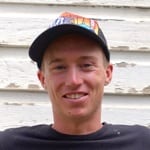I started mountain running at the Hardrock Hundred, which is why I have such strong sentiments toward the aspects in mountain running of camaraderie and respect for the environment. Hardrock is a race that could attract 1,500 runners or more every year, but which restricts itself–on the pretense of U.S. Forest Service limitations–to 140. Hardrock was borne of a deep love of adventure and the San Juan Mountains. It came from a group of people who had known and loved the area for decades, often participating in some of the greatest adventures the Colorado mountains have yet seen. In 1988, Hardrock race director Dale Garland and three others ran the entirety of the brand-new and largely nonexistent Colorado Trail in about 17 days. The same feat has been repeated many times since and much faster, too, but their pioneering effort into the unknown underscored the passion for the mountains that would eventually lead to Hardrock.
Of course, ‘unknown’ is relative. The miners who swept into the area beginning in the 1860s learned the land intimately as they toiled and sweated under backbreaking labor to extract minerals. The Native Americans before them likely knew the area even better, but their stories are lesser known. Hardrock the race is dedicated to the miners. In an homage to their hard work and desperate lifestyles, the race loops through many old mining towns in the region as well as countless high-alpine basins, valleys, and peaks where the mining debris is still very obvious. The race is undoubtedly one of the hardest hundreds in the world, but it holds much more appeal than many other ‘harder’ hundreds, which are often more difficult simply for the sake of being more difficult.
Hardrock is a race intended for people who love the mountains. It’s an event tailored to people who travel in the mountains for the sake of personal and spiritual renewal. It values people and landscape far more than times and records. Fittingly, the ‘Hardrock family’ has surrounded the event since its inception in 1993. This group of people returns year after year to be part of the mountains, the challenge, and the camaraderie that has grown around them. No event is quite like Hardrock because Hardrock is not simply a race. It’s a mindset manifest.
So, when I first visited Hardrock at 17, the physical challenge was only one part of what attracted me. The real draw lay in the combination of that physical challenge with a deep love of the mountains and the people sharing the challenge. It was, in one word, respect. Respect for the environment. Respect for the history of the region. Respect for the people drawn to such a challenge and the strength of partnerships that naturally arise from so difficult an undertaking. Hardrock doesn’t dive into the mainstream world of mountain running like every other race because Hardrock was founded on much stronger principles than public notoriety and money.
That’s not to say that the race doesn’t encourage competition. The winners’ times are dutifully noted and applauded every year. Kyle Skaggs and Diana Finkel–the two course-record holders–are heroes among the Hardrock family. Furthermore, the huge demand for the race has elicited responses such as restructuring the lottery system, rethinking the qualifying events, and working with the U.S. Forest Service to increase the race’s numbers. What sets Hardrock apart in this sphere is that, in addition to all the attention and admiration heaped onto the winners, the exact same amount of attention and admiration is heaped upon the last finishers. The best example of this is one of the race’s traditions. At 5:00 a.m. on Sunday morning–one hour before the 48-hour cutoff–everyone gathers to cheer in the last finishers, all of whom have just survived two full days and nights of mountain running in the San Juans.
That’s the spirit that makes mountain running so special. And it’s the spirit to which we must remain true. That spirit is why athletes should only have sponsors whose products they actually use, rather than endorse a host of energy drinks and gimmicks that would pay much more. It’s why races should focus on mountain running, instead of the business behind mountain running. Getting paid to do what you love is great, as is mainstream popularity and high-profile racing. Getting lots of money to endorse products that have little in common with what you actually do is to give up on the values that make the sport special. If the values aren’t given consideration they will disappear, and with them will go the culture of respect that makes mountain running so special.
I make a living off mountain running, but that doesn’t mean I have to sacrifice the values that keep this sport special. I run for only companies whose products I use and believe in. To support brands that make big money but no necessary products is to sacrifice one’s own integrity as an athlete, as a person. At least in mountain sports, where the environment dictates the passion, we have a responsibility to stand up for that environment and the culture it has created. If we lose our roots, we lose the reason for being part of all this in the first place.
Call for Comments (from Meghan)
- Dakota has discussed his ‘roots’ in our sport, the ethic and values of the Hardrock family. What are your roots? Where did you begin and how have your beginnings shaped your present relationship with trail and ultrarunning?
- What values of trail and ultrarunning do you hold dear, and do you think should stand the test of time, commercialization, and growth?
